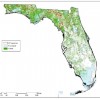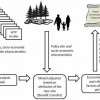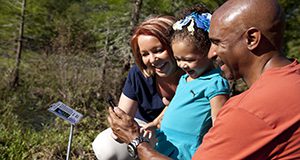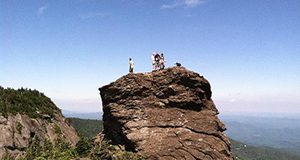Although millions of people recreate in parks, forests, and other conservation areas in the United States every year, research shows that some are left out; not everyone takes advantage of natural areas for the numerous benefits nature-based recreation provides. Results show that many people who do not participate in nature-based recreation feel constrained by their quality of time, not the quantity of time. In other words, they're saying, "Prove to me that it's worth my time to go out in nature. Show me something cool!" Based on research conducted in Hillsborough County, Florida and similar studies, this 6-page fact sheet written by Margaret E. Gullion and Taylor Stein and published by the UF/IFAS School of Forest Resources and Conservation addresses identifies strategies to improve the opportunities natural areas can provide a diverse public.
http://edis.ifas.ufl.edu/fr415
Tag: Taylor Stein
Trails, Bridges, and Boardwalks
Trails represent a landowner’s main routes for recreational activities such as walking, sightseeing, horseback riding, and bicycling. They provide access to, and through, forest land and other natural resources. They play an important role in protecting and preserving soil, water, and wild plants and animals. They can be the source of endless hours of enjoyment and relaxation. This 13-page fact sheet written by Alan Long, Anne Todd-Bockarie, Taylor Stein, Keith Bettcher, and Chris Demers and published by the School of Forest Resources and Conservation will help you plan your trails wisely and construct them carefully so that you and your guests can enjoy them to the fullest.
http://edis.ifas.ufl.edu/fr401
Public Land Management Agencies’ and Nonindustrial Private Forest Landowners’ Perceptions towards Ecosystem Services
 The state of Florida has more than 16 million acres of forestland. From clean air to pulp for paper to aesthetic landscapes, humans benefit from private and public forests in many different ways. However, small private landowners and public land management agencies manage the majority of this land, and it is up to these people to decide how society will benefit from those forests. This paper uses the concept of ecosystem services to explore the reasons why public land management agencies and private landowners manage their forests. This 5-page fact sheet was written by Taylor Stein, Namyun Kil, Alexis Frank, Alison E. Adams, Damian C. Adams, and Francisco J. Escobedo, and published by the UF Department of School of Forest Resources and Conservation, July 2013.
The state of Florida has more than 16 million acres of forestland. From clean air to pulp for paper to aesthetic landscapes, humans benefit from private and public forests in many different ways. However, small private landowners and public land management agencies manage the majority of this land, and it is up to these people to decide how society will benefit from those forests. This paper uses the concept of ecosystem services to explore the reasons why public land management agencies and private landowners manage their forests. This 5-page fact sheet was written by Taylor Stein, Namyun Kil, Alexis Frank, Alison E. Adams, Damian C. Adams, and Francisco J. Escobedo, and published by the UF Department of School of Forest Resources and Conservation, July 2013.
http://edis.ifas.ufl.edu/fr380
Valuing the Ecosystem Services of Florida‹s Forest Conservation Programs: The Economic Benefits of Protecting Water Quality (FOR309/FR377)
 How much are Floridians willing to pay for water quality protection programs that include forest conservation? This 9-page fact sheet reports the results of a study to answer this question, using a benefit transfer approach. Written by Melissa M. Kreye, Francisco J. Escobedo, Damian C. Adams, Taylor Stein, and Tatiana Borisova, and published by the UF Department of School of Forest Resources and Conservation, April 2013.
How much are Floridians willing to pay for water quality protection programs that include forest conservation? This 9-page fact sheet reports the results of a study to answer this question, using a benefit transfer approach. Written by Melissa M. Kreye, Francisco J. Escobedo, Damian C. Adams, Taylor Stein, and Tatiana Borisova, and published by the UF Department of School of Forest Resources and Conservation, April 2013.
http://edis.ifas.ufl.edu/fr377
Integrating Sustainability into Your Ecotourism Operation (FOR277/FR339)
Despite ecotourism’s promotion of sustainable practices and principles, the potential for negative impacts are great in sensitive, nature-based areas such as protected, conserved, and private lands. This 5-page fact sheet provides insight on sustainability practices that could be integrated into ecotourism operations to minimize negative impacts and ensure long-term protection of vital resources. Written by Tinelle D. Bustam and Taylor Stein, and published by the UF Department of School of Forest Resources and Conservation, December 2010.
http://edis.ifas.ufl.edu/fr339
How to Develop a Marketing Plan for Your Ecotourism Business (FOR278/FR340)
Ecotourism is often seen as a simple business for landowners to begin because little infrastructure is needed; however, certain management skills are needed to effectively operate an ecotourism business. A key business skill is the ability to market one’s ecotourism product or service effectively. This 7-page fact sheet describes the contents of a marketing plan and presents external resources to assist in ecotourism operation marketing. Written by Tinelle D. Bustam and Taylor Stein, and published by the UF Department of School of Forest Resources and Conservation, December 2011.
http://edis.ifas.ufl.edu/fr340
FOR237/FR299 Principles for Developing Your Ecotourism Business Plan
FOR237, a 6-page fact sheet by Tinelle D. Bustam and Taylor Stein, provides those wishing to begin an ecotourism business or modify an existing business with a detailed description of the diversity in ecotourism business models and the components necessary to develop an ecotourism business plan. Includes references. Published by the UF School of Forest Resources and Conservation, May 2010.
http://edis.ifas.ufl.edu/fr299
FOR187/FR242 Expanding Florida’s Farming Business to Incorporate Tourism
FOR-187, a 5-page fact sheet by Wendy Francesconi and Taylor Stein, proposes bringing Florida’s two economic engines, tourism and agriculture, together. Describes the current farming situation in Florida, why Florida farmers should consider agritourism, and planning needed for an agritourism operation. Includes references. Published by the UF School of Forest Resources and Conservation, June 2008.
http://edis.ifas.ufl.edu/FR242

